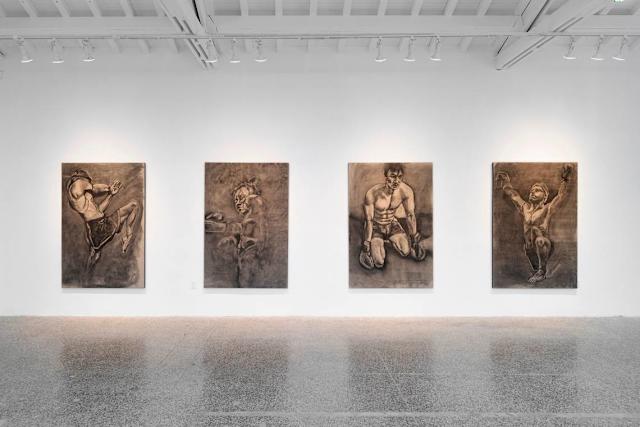Part 1: Introduction to Rocco Ritchie Art
Background of Rocco Ritchie
Born on August 11, 2000, in Los Angeles, California, Rocco John Ritchie entered the world as the first son of two entertainment industry titans: pop icon Madonna and acclaimed filmmaker Guy Ritchie. His arrival coincided with the height of his parents’ celebrity status, placing him immediately in the spotlight of international media attention. Despite this extraordinary beginning, Rocco’s journey would ultimately lead him away from the traditional paths of entertainment celebrity toward the more contemplative world of contemporary art.
Growing up between New York, Los Angeles, and London, Rocco experienced a multicultural upbringing that would profoundly influence his artistic sensibilities. His dual citizenship, American through his mother and British through his father, provided him with unique perspectives on different art scenes and cultural approaches. This early exposure to diverse environments would later manifest in his work as a painter, where themes of identity, displacement, and cultural observation become central elements.
The artist’s childhood was marked by extraordinary privilege, including private education, first-class travel, and exposure to some of the most influential figures in art, music, and film. However, it was also characterized by intense media scrutiny that would later inform his artistic exploration of privacy, fame, and personal identity. These early experiences with paparazzi attention and public examination would become crucial source material for his mature artistic work.
Early Beginnings in Art
From a young age, art provided Rocco with what he describes as “a place to escape.” Unlike many celebrity children who might naturally gravitate toward music or acting, Rocco found solace and expression through visual art, particularly drawing and painting. His early attraction to artistic creation was nurtured by a household environment that valued creativity and cultural appreciation, even though neither parent was a visual artist.
The foundation of his artistic education began informally through exposure to his parents’ collections and the constant presence of creative professionals in their social circle. Madonna’s collaborations with renowned designers and visual artists, combined with Guy Ritchie’s cinematic eye for composition and visual storytelling, created an environment where artistic appreciation was not merely decorative but essential to daily life.
As Rocco grew older, his interest in art evolved from childhood hobby to serious passion. He began developing his observational skills and technical abilities through consistent practice and study. This early period was characterized by exploration of different media and styles, as he worked to understand both traditional techniques and contemporary approaches to visual expression.
Pseudonym and Anonymity in Art
The decision to create art under the pseudonym “Rhed” represents one of the most significant strategic choices in Rocco’s early career development. This artistic alias emerged from his desire to establish credibility and develop his voice without the overwhelming influence of his family’s fame. As he explained in interviews, “Rhed was a mask until it wasn’t,” serving as protection during his formative period as an artist.
The name “Rhed” itself carries no deep symbolic meaning, chosen primarily for its sound and brevity rather than conceptual significance. However, the decision to use a pseudonym reflects a sophisticated understanding of how celebrity status can both help and hinder serious artistic development. By creating distance between his family identity and his artistic practice, Rocco was able to receive honest critical feedback and develop authentic relationships within the art world.
This period of anonymity lasted several years, during which Rhed participated in group exhibitions and began building a reputation based solely on the merit of his work. The gradual revelation of his true identity around 2022 marked a transition from emerging artist to established presence in the contemporary art scene, demonstrating that his work could stand independently of his famous parentage.
Part 2: Rocco Ritchie’s Artistic Journey
Influences from Father, Guy Ritchie
While Guy Ritchie is primarily known for his dynamic filmmaking and distinctive visual style, his influence on Rocco’s artistic development extends far beyond technical considerations. The filmmaker’s approach to composition, narrative structure, and visual storytelling has profoundly shaped how his son approaches painting and drawing. Guy’s emphasis on precise framing and dramatic lighting can be observed in Rocco’s figurative work, where careful attention to composition creates powerful emotional impact.
The director’s appreciation for British culture and history has also influenced Rocco’s artistic development, particularly his growing fascination with the School of London painters. Guy’s own engagement with British artistic traditions, combined with his international perspective from working in Hollywood, provided Rocco with a framework for understanding how contemporary artists can honor historical traditions while creating relevant new work.
Perhaps most importantly, Guy Ritchie’s work ethic and commitment to craft have shaped Rocco’s approach to his own artistic practice. The filmmaker’s dedication to technical excellence and continuous improvement serves as a model for how serious creative work requires sustained effort and constant learning. This influence can be seen in Rocco’s decision to pursue formal artistic education rather than relying solely on natural talent or family connections.
Transition into the Art World
Rocco Ritchie art education began in earnest when he enrolled at Central Saint Martins in 2018, one of London’s most prestigious and influential art schools. This institution, known for producing groundbreaking artists, designers, and creative professionals, provided Rocco with his first formal training in fine art techniques and contemporary artistic discourse. The decision to study at Central Saint Martins represented a serious commitment to artistic development and placed him within a tradition of innovative creative thinking.
Following his time at Central Saint Martins, Rocco continued his education at the Royal Drawing School in London, where he spent several years developing his draftsmanship skills. This institution, founded on the principle that observational drawing forms the foundation of all visual art, provided him with the technical skills necessary for his figurative painting approach. The Royal Drawing School’s emphasis on traditional technique combined with contemporary relevance aligned perfectly with Rocco’s artistic vision.
The transition from student to practicing artist occurred gradually, with Rocco participating in group exhibitions while still developing his voice and technique. His early exhibitions under the Rhed pseudonym allowed him to build relationships within the London art scene and receive critical feedback without the complications of celebrity association. This careful approach to career development demonstrates an understanding of the art world that goes beyond mere talent to encompass strategic thinking and professional development.
Evolution of Style and Approach
Rocco’s artistic style has evolved significantly since his early student work, moving from experimental exploration toward a more focused figurative approach that draws heavily on British painting traditions. His current work demonstrates strong influences from Francis Bacon, Lucian Freud, Frank Auerbach, and David Hockney, artists who represent different aspects of 20th-century British art. This influence places him within a contemporary movement of artists revisiting and reinterpreting figurative painting traditions.
The evolution of his approach can be seen in his increasing confidence with bold color choices and expressive brushwork that recalls both expressionist traditions and contemporary neo-expressionist movements. His paintings demonstrate an understanding of how color and gesture can convey psychological and emotional content beyond mere representation. This maturation reflects both technical development and increasing conceptual sophistication.
Recent exhibitions have shown Rocco exploring themes related to identity, travel, and cultural observation, subjects that reflect his own experiences growing up between different countries and cultures. His series “The Tourist” explicitly addresses questions of belonging and cultural positioning, while maintaining the figurative approach that has become his signature style. This thematic development suggests an artist moving beyond technical proficiency toward meaningful artistic content.
Part 3: Rocco Ritchie’s Impact on the Art Scene
Exhibitions and Recognition
Rocco’s exhibition history demonstrates a carefully planned progression from anonymous group participation to major solo presentations in international art centers. His early exhibitions under the Rhed pseudonym, including shows at Tanya Baxter Contemporary in London, established his presence in the British art scene and provided valuable experience in presenting work to collectors and critics.
The 2024 “Pack a Punch” exhibition in Miami’s Design District marked a significant milestone in Rocco’s career, representing his first major presentation under his own name to an international audience. This two-day pop-up exhibition, organized by dealer Jessica Draper, demonstrated his ability to attract serious collector interest and media attention based on artistic merit rather than celebrity association. The success of this exhibition led to increased recognition within the contemporary art market.
His most recent exhibition, “The Tourist,” presented in Paris with backing from Giorgio Armani, represents the culmination of his artistic development to date. This show, which explored themes of cultural displacement and identity through his distinctive figurative style, received significant critical attention and demonstrated his evolution from emerging artist to established contemporary painter. The international scope of his exhibition history reflects growing recognition of his artistic significance.
Critic and Public Opinion
Critical reception of Rocco’s work has evolved significantly as his artistic identity has become more established and his technique has matured. Early reviews, when his identity was still concealed under the Rhed pseudonym, focused primarily on technical proficiency and potential for development. Critics noted his strong draftsmanship skills and interesting color choices while encouraging continued exploration of thematic content.
As his true identity became known, critical discourse shifted to include consideration of how his background informs his artistic vision. Rather than dismissing his work as celebrity vanity, critics have increasingly recognized the authentic artistic vision that emerges from his unique perspective on fame, privacy, and cultural identity. His series exploring paparazzi photography and media representation has been particularly well-received for its sophisticated approach to complex contemporary issues.
Public reception has been overwhelmingly positive, with collectors including fashion designers Stella McCartney and Donatella Versace acquiring his work for their personal collections. This collector interest demonstrates that his work appeals to sophisticated audiences who understand both artistic merit and cultural significance. The support he receives from established figures in the art and fashion worlds suggests genuine respect for his artistic achievements.
Comparison to Contemporary Artists
Within the context of contemporary figurative painting, Rocco’s work occupies an interesting position between traditional British painting traditions and international contemporary trends. His approach recalls the psychological intensity of Francis Bacon while incorporating the color sensibility of David Hockney and the gestural freedom of contemporary expressionist painters. This combination places him within a generation of artists who are revitalizing figurative painting for contemporary audiences.
Compared to other celebrity-adjacent artists, Rocco’s commitment to serious artistic education and technical development sets him apart from those who might rely primarily on name recognition. His decision to pursue formal training at prestigious institutions and to work under a pseudonym demonstrates an approach more similar to career artists than celebrity hobbyists. This seriousness of purpose has earned him respect within the art community.
His exploration of themes related to fame, privacy, and cultural identity places him alongside other contemporary artists who address similar concerns, but his unique position as someone who has experienced these issues firsthand provides his work with authenticity that purely conceptual approaches might lack. This personal connection to his subject matter strengthens the emotional impact of his paintings and distinguishes his work from more theoretical treatments of similar themes.
The international scope of his exhibition schedule, with shows in London, Miami, and Paris, demonstrates his ability to appeal to diverse cultural contexts while maintaining a consistent artistic vision. This global approach reflects both his multicultural background and the universal appeal of his artistic concerns. As he continues to develop as an artist, his work increasingly demonstrates the potential to make lasting contributions to contemporary figurative painting traditions.
Looking toward the future, Rocco’s artistic trajectory suggests continued growth and development as he explores new themes and techniques. His co-founding of Maison Rhed gallery with friends demonstrates entrepreneurial spirit and commitment to supporting other emerging artists. This involvement in the broader art community, combined with his growing international recognition, positions him as an important voice in the next generation of contemporary painters.
The evolution from Rhed to Rocco Ritchie represents more than a simple revelation of identity; it marks the successful transition from protected artistic development to public artistic recognition. His work now stands as evidence that serious artistic achievement can emerge from celebrity circumstances when approached with dedication, education, and authentic vision. As his career continues to develop, Rocco Ritchie art promises to offer increasingly sophisticated explorations of contemporary life and cultural identity through the enduring medium of painting.






